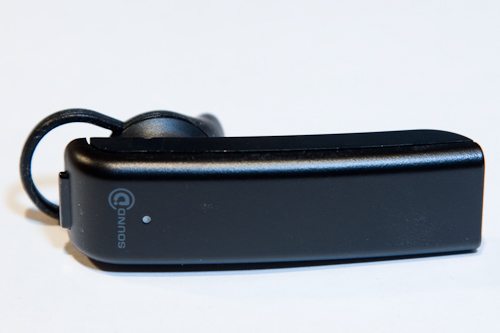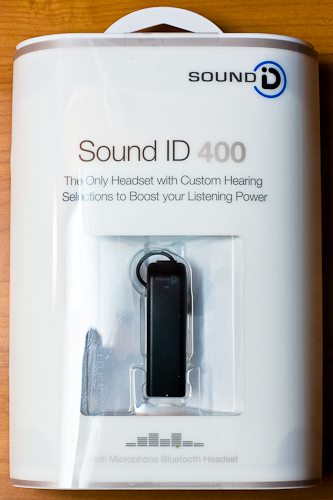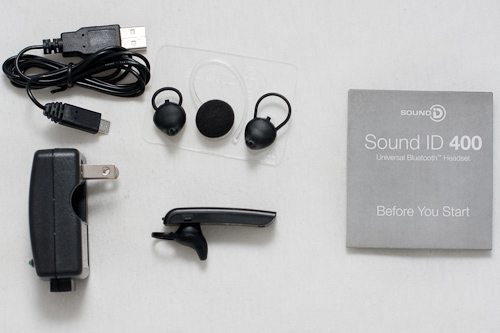
When Julie announced the Sound ID 400 I couldn’t wait for it to be announced. Small, simple and packed with features like PersonalSound (enhanced listening power) and Automatic Volume Control (self-explanatory) in a nice looking package. Well I’ve been using the headset for a little while now, and was surprised by how it performed.
The Sound ID 400 is the fourth generation bluetooth headset from Sound ID. It is visually very similar to their previous three headsets (which I have not used personally). It is all black with a faint Sound ID logo and only has two buttons: the Main Button and a single volume button. In addition, there is a tiny status light on the front of it and a micro-USB charging port on the back of it (the part that rests against your cheek). It comes with three earpieces — two in-ear sizes and an over the ear loop with a foam cover. The box also includes a micro-USB to standard-USB cable and a wall charger with a USB port. (I love these modular chargers since they can be used with any device.) Personally I would have preferred a mini-USB connection on the headset so I could use the many cables I have, but I understand that micro-USB is getting more standard and is better than a proprietary connection.
The headset itself is “standard” sized at 2.1″ by .6″ and weighing in at a very light 8 grams. The stated talk time is 7 hours and the standby time is 8 days. I did not test these values but “standby time” may be affected by the fact that the headset turns off after a period of non-use. Of course with it off the battery will last a long time.
As of this review the headset is only available direct from SoundID.com’s website which is curious. It retails for $129.99 which is on the high-end. You can get the Plantronics Voyager PRO for $85 or the Plantronics Discovery 975 for about ~$130.


The headset itself walks a fine line between boring and sleek, but I’m not sure which side I feel it sits on. It has a clean matte black look with no unnecessary design elements. It’s the type of headset that no one will ask you about and most people won’t even notice. For the style conscious (not me) it would work for everywhere from the beach to the boardroom without looking out-of-place. From a functionality point of view it has some huge problems. The first problem is no doubt touted as a feature: the single volume button. There is no up or down, just up. When you reach the max volume it cycles around to the bottom and so on. It’s not a deal breaker, but it is odd at best and annoying most of the time. Simply adding a second volume button would not have any negative impact on style and would improve function. Having said that, the Automatic Volume Control really does seem to work, and I’ve not yet had to adjust the volume on a call.
Then there’s the Main Button. The Main Button, the one that answers and ends calls, pair it with your phone and basically do everything non-volume related was clearly placed by a team that did not have ears. The Main Button sits on the end of the headset opposite the microphone and in order to press it you have to wedge your fingers between the headset and your ear. Maybe my ear has a weird cartilage setup, but when I want to press this button it involves squishing my ear back and wiggling the headset. It’s quite annoying, and honestly if I had purchased the headset this problem alone would have caused me to return it.
It may seem like TMI, but it does apply to this review: I am a lazy groomer, and as such I do not shave every day. The way the Sound ID 400 sits against my cheek when I open my mouth to talk, yawn or chew the stubble rubs against the headset and makes a scratchy sound. It’s annoying. Now, I have a fat face so if you have a thinner face it may not rub as much. Of course women (who aren’t in the circus) won’t have this problem. I have never used the Jawbone, so I don’t know if this happens with it as well since it sits against the users’ cheek. But, for this review it’s a negative and almost makes me want to just shave that small patch on my cheek each day. Almost.
From a comfort perspective this is a very comfortable headset. I use the smaller of the two in-ear loops and it fits perfectly. I can shake my head till I almost black out and this headset isn’t going anywhere. Also, it feels quite durable and I wouldn’t hesitate to throw it in my pocket or bag without worrying that it will break.
So of course the big question is how well does the headset perform? This is a mixed bag. For the wearer, the quality is excellent and very clear. For the person on the other end of the call, it depends. Some callers I spoke with said it sounded like I was in a tunnel or elevator and things had an echo. Other times everything sounded fine. In a quiet environment the headset works very well, but as the background noise increases, the quality decreases. It features dual microphones (the main one and one on the opposite side) designed to detect and eliminate background noise, but I can’t see that they offer anything above a single microphone headset. My other headset is the awesome Joby Zivio Boom so that’s what I was comparing to (I just found out that the Joby Zivio Boom is discontinued!). There is a clear difference between the Sound ID and the Zivio, and especially when in a moving vehicle with background noise the Sound ID tends to be very distorted at times. Here are two examples of each with background noise (traveling 60mph in the car) and no background noise.
Sound ID 400 with NO background noise (33KB .WAV File)
Sound ID 400 WITH background noise (66KB .WAV File)
Zivio with NO background noise (33KB .WAV File)
Zivio WITH background noise (225KB .WAV File)
I have also found that about 75% of the time when a call connects I hear a very short but loud burst of static in the headset. It’s really annoying, but I have not been able to identify when or why it happens. It does not happen on my Zivio, and does not happen all the time. I can go a day or two without the static, then the next day it’s static city. After over a week of use, it’s now at the point where I cringe when I’m placing a call in anticipation of the static.
The Sound ID 400 does offer some unique features such as PersonalSound, Environmental Mode, NoiseNavigation and Automatic Volume Control. Notice I said “unique” and not “cool” or “useful”.
PersonalSound just makes everything sound increasingly “echoy” and really is an odd feature. It just makes things sound like it’s been electronically enhanced (as it has). I suppose it could be useful if you’re in a really loud environment, but then you would just want to increase the volume instead.
Environmental Mode is something that seems great on paper, but just doesn’t work. When you’re wearing your headset and not on a call if you hold the volume button for about two seconds it activates Environmental Mode. This enables the microphone on the headset and plays it through the earpiece. This would be a great feature, except for the noticeable and increasingly annoying hiss that also plays. In fact, turning it off after using it for just a minute is an amazing relief. I don’t quite feel like shouting “THERE ARE FOUR LIGHTS“, but it’s close. If the hiss weren’t there, it would be an awesome feature. As it is, I’ll never use it. Also, when the microphone is enabled our old friend “stubble scratch” shows up again since the microphone is activated and rubbing against my cheek.
NoiseNavigation uses dual microphones on the headset (the main one against the cheek and one on the back by the Main Button) to optimize sound and remove background noise. I can’t say if this works or not, but background noise is fairly well controlled. If it weren’t for the echo sound of the headset itself, it would be easier to tell how well background noise is removed.
As previously mentioned, Automatic Volume Control does seem to work well and I’ve not had to adjust the volume since I started using it. This is actually a really nice feature and I hope it starts showing up in other headsets.
One “quirk” I found is that the Sound ID 400 shows up as SOUND ID 300 on my Verizon Wireless Touch Pro 2. It works fine and definitely IS a Sound ID 400, but it’s just strange. What’s even more strange is that on my laptop it shows up correctly as SOUND ID 400. I’ve added and removed it and it always shows up the same way.
To round out the list of negatives, the Sound ID 400 cannot activate Voice Command and cannot reject a call. These are both very important features for anyone who uses their phone while driving. Voice Command has become very useful to me and rejecting a call is just a nice feature that is standard on almost every other headset.
I truly do not intend this review to just bash the Sound ID 400, but honestly for a fourth generation product it is a huge disappointment. Having read some other reviews on the headset it is possible that I have a lemon, but really the design elements (awful button placement and single volume button) poor performance, incorrect bluetooth name and call connect static are just not excusable for a mature product. Personally I will not be using this headset anymore and will probably leave it in my car as an emergency headset. I was really looking forward to this product after the initial Gadgeteer spotlight, and am quite disappointed by the results. I cannot recommend this headset as there are better choices on the market.
Google Review Tap Cards (3-Pack) by TapFive - Tap for Instant Reviews - All Phones Compatible - Reusable Smart Tap NFC & QR - Boost Business Reviews - Powered by TapFive (3 Card Pack)
$34.90 (as of December 1, 2025 17:54 GMT -05:00 - More infoProduct prices and availability are accurate as of the date/time indicated and are subject to change. Any price and availability information displayed on [relevant Amazon Site(s), as applicable] at the time of purchase will apply to the purchase of this product.)REVLIXI Google Review Stand -Boost Reviews w/Reusable Google Review Tap Card Stand & QR Code Stand- No App or Subscription - Android & iPhone Compatible-Boost Google Reviews for Online Growth
$24.89 (as of December 1, 2025 17:54 GMT -05:00 - More infoProduct prices and availability are accurate as of the date/time indicated and are subject to change. Any price and availability information displayed on [relevant Amazon Site(s), as applicable] at the time of purchase will apply to the purchase of this product.)Product Information
| Price: | $129.99 |
| Manufacturer: | Sound ID |
| Pros: |
|
| Cons: |
|



Gadgeteer Comment Policy - Please read before commenting
I can’t agree with this review. After trying numerous headsets from Jawbone, Jabra, Motorola, and Plantronics, I settled on the Sound ID 300, which I’ve been using for almost a year. Picked one up for my wife as well; we both found the 300 to be superior in terms of clarity, comfort, and noise cancellation.
I recently purchased the Sound ID 400 model, because it has the added capability of multipoint- a feature you completely missed in your review. Now I can use the headset and answer or make calls as needed on my iPhone 3GS and my corporate Blackberry 8830, without needing to disable one and re-connect the other. Since I live in California and have a significant drive time each day, this added feature keeps me “legal” and eyes on the road!
The controls on the Sound ID 400 (and 300) are a bit different than other headsets, but if you wear it at the correct angle, you can easily reach both buttons without effort or discomfort. I drive an older SUV with a fair amount of noise, and my wife drives a convertible. Neither one of us has trouble hearing with the Sound ID, and when we call each other, we hear each other quite clearly- non-voice sound frequencies just don’t get sent through the connection. Neither of us experience the “burst of static” that you refer to.
Just for comparison, I recently took an extended business trip to the East Coast and forgot to grab the Sound ID 400 before departing. I picked up a Jawbone Prime to try it out and tide me over- using the best fit option for the Jawbone hurt my ear after several days, and the necessity of keeping the “noise assassin” switch in contact with my cheek was annoying. I was more than ready to use the Sound ID 400 when I returned home, and promptly returned the Jawbone Prime for a refund.
Not my intention to downplay your review, but wanted to say that my experience with the Sound ID 400 has been completely positive. Highly recommended!
Terence:
Thanks for the excellent comment. You’ve brought up a lot of good points, but I do want to stress that the review was based on the headset that I received. It was a production unit like anyone would buy, so if I hadn’t received it someone else would have.
The unit I had certainly had a list of problems (the static, incorrect bluetooth name, poor sound quality, etc). It’s entirely possible that it was a lemon and yours functions perfectly, but it still means that there are problems.
To some of your specific points: I have multiple cell phones, but only use my Touch Pro 2 for calls, so didn’t test out the multipoint. I’m California too, and also just don’t like dying in a car accident, so I use my headset all the time while driving. Not just a good idea, it’s the law. 🙂
I tried the headset out in a number of angles and they all had the same problem. I’m fully willing to admit that my ear is deformed, but honestly it must affect other people too who have similar ear shapes. I stand by the notion that you can’t design a product hoping that people don’t have funky ears like I do. (Now I’m all depressed about my stupid ears.) 🙂
I spent MUCH longer on this review than I intended (and much MUCH longer than Julie would have liked) to make sure I wasn’t just testing under unfair circumstances. You can clearly hear in the samples that the Sound ID 400 that *I* had has awful quality for the other party. Also, the burst of static truly was phenomenally annoying and really did make me want to stop using the headset.
I have never used any of the Jawbone headsets, so I can’t speak to that, but in the sound samples you can see how much clearer the Zivio Boom headset is. It’s not a perfect headset (and, as stated is no longer for sale which is a shame), but is clearly superior in sound quality.
To be clear, your comments truly are appreciated. Everyone has different experiences with products, but the unit I reviewed was faulty in many ways and I won’t be using again. I’m glad yours works for you and I really was disappointed that in my results because I wanted to switch to the Sound ID 400.
I am also having issues with this model. I get a loud initial burst of static and just generally not overwhelmed with the sound of it. When I first paired it listed it as the Sound ID 300 as well.
A couple of the same issues here.
The positioning of the button sucks for me, but the deal-killer is the inability to activate MS Voice Command on my phone.
Back to the Jabra BT8040 for now.
-Doc